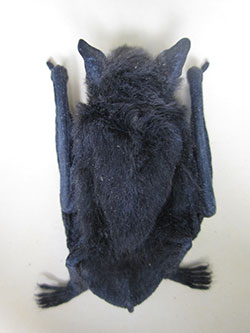Living With Bats
What to do if you find a dead bat or a bat behaving abnormally
If a person or pet was BITTEN/SCRATCHED/EXPOSED TO SALIVA from the bat, contact the Alaska Section of Epidemiology immediately:
Mon – Fri 8am – 5 pm: (907)269-8000 After Hours: (800)478-0084
- Never handle a bat — healthy, sick or dead — with bare hands!
- Do not handle a sick or dead bat unless instructed to do so or you need to remove it from your home or move it out of the way.
- Always wear gloves when handling a bat!

Please report sick or dead bats immediately and wait for further instructions. To make a report:
- Complete the online Bat Observation Report Form and please contact your local ADF&G office
How to collect a sick or dead bat if you are asked to do so by an ADF&G biologist
- Always wear gloves when handling a bat!
- Use leather gloves for a live bat
- Use rubber, vinyl or nitrile gloves to pick up a dead bat (if you do not have gloves, turn a ziploc bag inside out and pick up the bat with the bag)
- Live Bats:
- Call ADF&G for instructions before putting in a small box or plastic container for transport.
- Complete a Specimen Submission form (PDF 297 kB) and bring it along with the bat.
- Dead Bats:
- Seal it in a Ziploc bag or plastic/unbreakable container.
- Place the bag or container inside a second Ziploc bag and seal the second bag.
- Label the bag with the date, location and your contact information.
- Complete a Specimen Submission form (PDF 297 kB) and put it in the second bag with the bat.
Please do NOT freeze bat carcasses unless:
-
You are asked to do so by the ADF&G Wildlife Health Program staff member
or -
The carcass can't be shipped within 72 hours
or - You tried contacting ADF&G, but did not receive a response within 48 hours.
Chilled bats should be kept cold (35–45° F). If refrigeration is not possible, please keep out of the sun and cover with blue ice or wet ice in a sealed container.
Frozen samples should be kept frozen.
What do we do with the dead bats we collect?
All carcasses in reasonably good condition are examined by the ADF&G Wildlife Health and Disease Surveillance Program to determine the cause of death and test for disease. Fresh carcasses that have been chilled, but not frozen, are particularly valuable, because it is possible to run a wider variety of tests on fresh, unfrozen tissue. Afterwards, the carcasses are sent to the University of Alaska Museum, where they are available to scientists in Alaska and all around the world for research purposes. Even old carcasses are useful — in fact, bat carcasses mummify really well and can be a valuable source of DNA. Most of the bats in the museum's collection were turned in by members of the public, so thank you for taking the time to report dead bats to us!
Why is it so important to report dead bats?
Testing dead bats is one of the only ways that we will be able to detect White-nose Syndrome (WNS) in Alaska. WNS is a deadly fungal disease that has already killed millions of bats in the eastern half of North America. In March, 2016, hikers found and reported a sick bat on a trail about 30 miles east of Seattle. The bat tested positive for WNS, representing a sudden westward jump of 1,300 miles in the spread of the disease. Because most eastern bats hibernate in large groups in caves and mines, until now biologists have been able to track the spread of the disease by entering caves in winter and swabbing the bats on the walls and ceilings. However, bats in Alaska don't hibernate in caves or mines, so biologists will be relying on you to help detect and track the spread of the disease in the state. If a bat with WNS manages to survive the winter, it can clear the fungus within a few weeks of emerging from hibernation, so carcasses collected during November - May provide the best chance of detecting the disease.
Help spread the word! Click here for a flyer you can post or email (PDF 380 kB).
